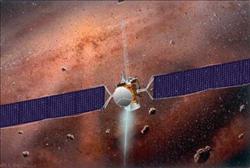NASA’s Dawn spacecraft began its 1.7 billion mile journey through the inner solar system to study a pair of asteroids Thursday at 7:34 A.M. EDT.
Dawn is scheduled to begin its exploration of Vesta in 2011 and Ceres in 2015. The two icons of the asteroid belt are located in orbit between Mars and Jupiter and have been witness to so much of our solar system’s history.
By using the same set of instruments at two separate destinations, scientists can more accurately formulate comparisons and contrasts. Dawn’s science instrument suite will measure shape, surface topography and tectonic history, elemental and mineral composition as well as seek out water-bearing minerals.
A critical milestone for the spacecraft comes in is acquiring its signal. The launch team expects that to occur in approximately 2 to 3 hours.










